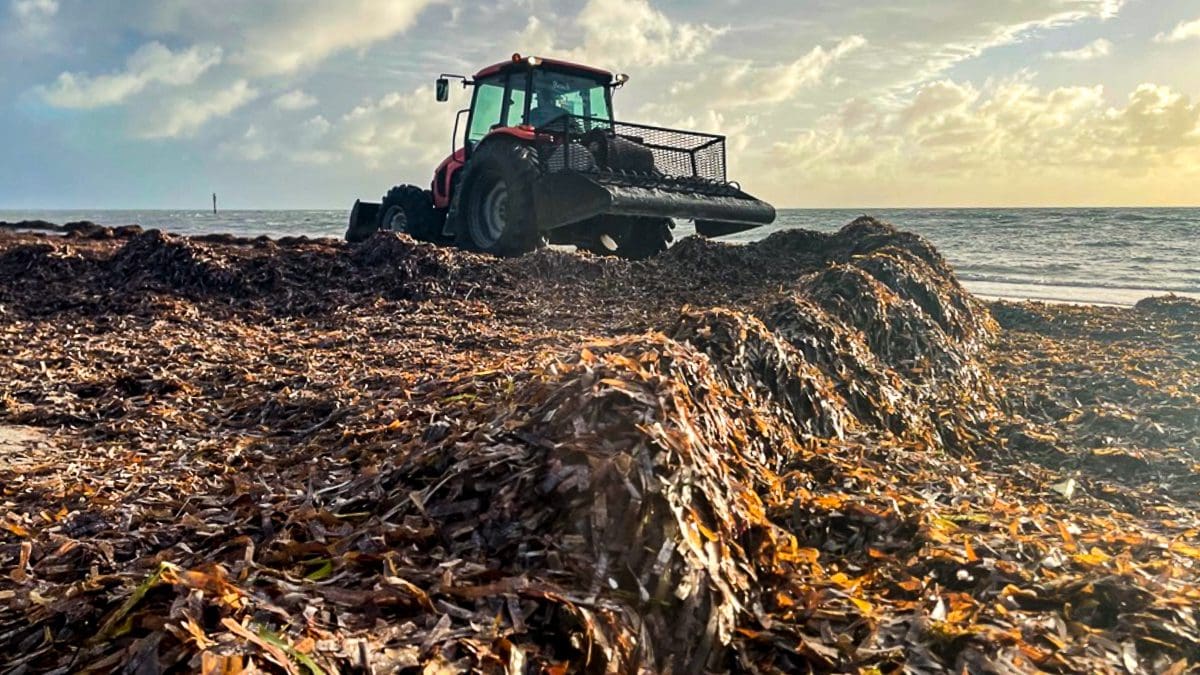Ah, the summer in South Florida. The snowbirds and spring-breakers have fled up north and it’s a time where locals and visitors immune to the heat and humidity can once again take the beachhead.
Unfortunately, an unwelcome repeat visitor is coming: sargassum, a free-floating brown seaweed that this summer officials fear will turn the Island Paradise’s beaches into a nearly inhospitable hellscape.
A 5,000-mile-long, 12-million-ton belt of seaweed is heading across the Caribbean towards South Florida. The peak of the bloom is expected to be on Florida shores in May and June.
Key Biscayne Village Manager Steve Williamson said at the council meeting Tuesday the event could have a severe impact on the island.
“This is obviously a health issue and it could be a cost issue, but again, it’s a tourism, economic issue,” he said. “People come to Florida to go to our beaches.”
Mayor Joe Rasco said he has spoken to Tallahassee officials and Florida’s congressional delegation about the bloom.
“We started putting this on everybody’s radar. It’s like, ‘Hey, this thing is common. Is there a plan?’” he said. “This is potentially a tremendous problem for us as we approach summer.”
The Village Council passed a resolution urging Congress and the Florida Legislature to appropriate funds for sargassum seaweed removal on beaches. Williamson also said he is coordinating with Miami-Dade County officials who are trying to figure out how to compost the sargassum.
So where is this sargassum presently? Williamson said currently the belt is located between Cuba and the Yucatan Peninsula.
“At some point it’s going to come through there and it really depends on what the currents are at that point,” he said. “When it begins to approach Southwest Florida does the currents push it up north or does it push it though the Florida Straits?”
The current blob is roughly half of the record-setting total found last year in the Atlantic but it is still a lot – the University of Miami says it can fill 3,000 Olympic-sized pools.
This is nothing new for Key Biscayne — the island has been plagued by large blooms of sargassum since at least 2018.The Village has a whole webpage of information on how it deals with the seaweed, dedicating $550,000 to remove it and other sea grasses that wash up.
Last year, the city removed about 7,500 cubic yards – which translates to about 450 truck loads.
Sargassum is critical for marine life – shrimp, crab, fish, and other marine species have adapted specifically. But the seaweed, once ashore, emits a gas that smells like rotting eggs that can cause respiratory problems. For swimmers, it is sea lice paradise.
What is fueling the sargassum? Humans, of course. The blooms, which are seasonal and more prevalent since 2011, have been linked to fossil fuels, deforestation in the Amazon and discharges from major waterways like the Mississippi, Amazon and the Congo.
If people are the cause, some council members saw an opportunity to turn a sow’s ear into a silk purse.
Council member Fernando Vasquez, an engineer, told Williamson and Chief Resilience and Sustainability Officer Roland Samimy to look how blue-green algae in Lake Jessup northeast of Orlando is being turned into biofuel.
Rasco suggested grinding the seaweed down to remove the water to mitigate transportation costs.
Any way you look at it, sargassum is a money pit for taxpayers.
“The main cost is to transport the material to wherever it is that you’re going to be processing,” Samimy said.
There have been talks to partner with Miami-Dade and even private companies to process the sargassum, Samimy said,, but so far nothing has come to fruition.
Crandon Park uses a staging area where it dries out the sargassum and rakes it back into the sand. Virginia Key composts the seaweed. In St. Lucia, a company juices the seaweed for its nutrients. But efforts to get it to build a facility in Miami-Dade have yet to be successful.
Samimy said he was recently sailing between Guadeloupe and Puerto Rico and said there was some sargassum but not some sea monster that the media has made it out to be this season. Instead, it is spread out in patches in the vast ocean.
“They make it out as some continuous blob of seaweed making its way to Florida,” Samimy said.
Support local News. Every donation matters.
An earlier version of this story misidentified the location of a company that processes sargassum for nutrients.
JOHN PACENTI is a correspondent of the Key Biscayne Independent. John has worked for The Associated Press, the Palm Beach Post, Daily Business Review, and WPTV-TV.



